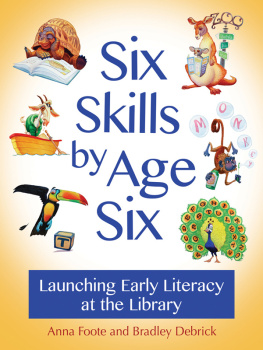Thanks must go to Peter Lambert, Vicki Cawthorn and the children at Chinley Primary School, High Peak, Derbyshire for inviting me in to the reception class to join in with their outdoor activities and allowing the use of a number of photographs.
Introduction

About the series
This series is intended for early years students and practitioners working with children aged two to five years. It aims to demonstrate how outdoor provision is just as important as the indoor classroom, and highlight the wealth of opportunities that the outdoor environment provides for teaching basic skills and concepts in maths, science and literacy.
In her review of the Early Years Foundation Stage (EYFS) in England, Dame Tickell (2011) recommended a focus on how children learn rather than what they learn. She identified three characteristics of effective learning; playing and exploring, active learning and creating and thinking critically. The books in this series outline the basic concepts and skills that underpin maths, science and literacy and show how the outdoor environment promotes an active, social and exploratory pedagogical approach to early learning.
Dame Tickell also singled out three prime areas of learning; communication and language, personal, social and emotional development, and physical development. She identified these as fundamentally important for laying secure foundations in preparation for more formal education. Therefore, these books promote early years practice that:
- Involves active practical activities that prompt lively debate and conversation, enabling children to develop the communication and language skills they need to find out about the world and make sense of new information, as well as discuss, extend and evaluate ideas;
- Gives children the chance to practise large and fine motor control, which is not only essential for cognitive development, but important in terms of gaining the strength and coordination needed for future writing and recording;
- Fosters physical and playful activity, promoting healthy personal, social and emotional development by reducing stress, improving mood and boosting motivation and learning.
The books contain a wealth of ideas for enhancing continuous outdoor provision, as well as planning focused maths, science and literacy activities that exploit the unique qualities of the outdoor environment. They also provide advice on planning and assessment, where to find resources and recommendations for further reading. Throughout each book there are links to all four British early years curricula.
Developing Literacy Outdoors
Children develop communication, language and literacy skills through interaction, conversation and play with others. The outdoor environment facilitates active and social play, where children practise speaking and listening to each other and act out roles that involve reading and writing. They do this in an unrestricted space that allows for vocal discussion and argument, which supports their language development and helps them to extend their knowledge and understanding of the world.
Early years pioneer Lev Vygotsky (1986) highlights the relationship between language and learning. It is his contention that language is the key to knowledge and thought. Children develop an understanding of the world by using language to label the things that they see and experience, enabling them to process information, describe and explain its meaning, as well as analyse, question, reason and evaluate. In short, language is what enables children to learn by helping them to take in information, extend their knowledge and form new ideas.
Vygotsky also stresses the importance of social interaction for learning. He advocates a social learning environment where children extend and develop their thinking through discussion with more knowledgeable others. Jerome Bruner (1966) supports this theory and further recommends physical exploration that helps children to develop understanding of basic concepts. He believes that children internalise the knowledge they gain through hands-on social learning experiences, which later leads to more complex abstract thought.
These theories are supported by the hugely influential Researching Effective Pedagogy in the Early Years (REPEY) and Effective Provision of Pre-school Education (EPPE) research projects, which identify the need for good quality verbal interactions that extend and develop thinking. The researchers advocate planning practical experiences for children to actively construct conceptual knowledge (Siraj-Blatchford et al, 2002) through a balance of taught and freely chosen yet potentially instructive child-initiated activities (Siraj-Blatchford et al, 2004).
All four British early years curricula place much emphasis on the importance of planning hands-on active learning experiences, through which children develop a wide vocabulary that enables them to talk about and describe their observations and experiences.
The outdoor learning environment is the ideal arena for language acquisition and development. Sensory exploration of the natural world not only requires children to tune in and listen, helping them to develop auditory discrimination in preparation for later reading and writing, but it helps them to build a rich vocabulary, enabling them to make connections between the physical world and the language that is used to describe it. Children can draw upon this bank of vocabulary to enrich the language they use when they talk and write.
Whats more, when they are outside children are less restricted and have the space to move around and develop the gross and fine motor control they need to be able to hold and control a pencil. There is room to move, dance and become acquainted with the directionality of written English, and there are opportunities to physically play with letters and sounds and make learning about phonics more interesting and interactive. Whats more, children can use the natural resources around them to make marks or create scenery and props when re-enacting stories and playing different roles.






